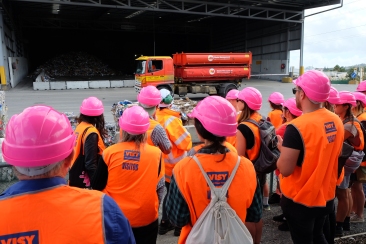
I was a child of the 80’s…an era when the prevailing environmental message was “recycle! recycle! recycle!”. I have fond memories of going on a school trip to the Coca Cola factory where they taught us about the many interesting ways that one could repurpose a plastic Coke bottle. We even got to take home the (*cough* propaganda) handy reuse booklet. Bird feeder, anyone?
So…they taught us about repurposing and about how important it was to recycle.
What they didn’t teach us was the fact that when a Coke bottle is recycled, it doesn’t turn into another Coke bottle. 
And it was only a couple of years ago that I learned the truth – that each time you recycle plastic, it is made into a product that is more inferior in quality and you can only do this 7-9 times before the integrity of the product degrades to the point where it will be sent to landfill.
Recycling, however, is still regarded as an important piece of the waste solution puzzle…and it does have its place. So, I thought I’d better learn more about the business of recycling and when the team at EcoMatters got in touch with me to ask if I’d like to come along on their tour to the Visy Recycling Centre in Onehunga, I jumped at the chance.
After a brief journey through the streets of Auckland, we rolled up in our bus and disembarked with the faint sweet stench of garbage in the air and seagulls circling overhead.

Visy is NZ’s largest recycling centre (otherwise known as a Material Recovery Facility or MRF) running 24/7 with 200 deliveries every day. They receive all of Auckland’s recycling (a hefty 230,000 tonnes each year), which they then sort, bale and forward to processing facilities, most of which are overseas.

Recycling trucks collect the contents of our curbside bins and make their way to Visy, where the loads are emptied onto a huge heap at the back of the building. The items are then picked up by a digger and dumped onto a conveyor belt that snakes its way into the facility.
A team of people do the pre-sorting, pulling non-recyclable items off the conveyer belt. It’s challenging work, made even more difficult by the need to handle some seriously unpleasant items (dirty nappies!)…so, think of those brave souls when you’re chucking things in the recycling bin and make sure that items are clean and actually able to be recycled.
The recyclables then go through a series of rotating cylinders with different sized holes to filter out different types of materials. Metals are collected by magnets and plastics are sorted by infrared cameras.
The recycling machine gets stopped at least once a day due to wraparound issues (non-recyclable materials jamming the machinery) and any untangling has to be done by hand (and can take up to an hour!).
After a short time in the education room, talking to Caroline, Visy’s educational advisor…we all donned high vis vests, safety glasses and shocking pink hard hats for our tour around the perimeter of the facility. I have to say, I was a little disappointed that we wouldn’t be able to see the factory floor. It would have been awesome to watch the machines at work, but, unfortunately, that area is highly restricted (for some reason), and no peeking is permitted.

As we watched the trucks driving in and emptying their contents and the digger hard at work, Caroline talked about some of the more unusual things that found their way to Visy. “You would not believe some of the things that people put into their recycling bins. Once we found an entire single mattress that had been squashed into a bin. We get a lot of hazardous waste – car batteries, paint tins, needles. All of the guys have to have Hepititus injections before working the machines. One time, a truck came in and, unbenownst to the driver, his load was on fire – a car battery had ignited. We had to wave him down and put out the fire. We’ve also had a rifle turn up. We had to shut the place down and call the police. And one time, someone even decided to try and recycle a dead cat.”

 In the same way that you can tell a lot about someone from the contents of their shopping trolley, Visy staff get an insight into Aucklanders’ lives based on our recycling habits and there are trends at particular times of the year. For example, in December and January, Visy receives tonnes of glass as a result of Christmas & New Years celebrations. In November/December, they get loads of cardboard and paper from Christmas gift-buying. And, in June/July, they collect mountains of milk bottles (cold weather equals lots of hot drinks, it seems).
In the same way that you can tell a lot about someone from the contents of their shopping trolley, Visy staff get an insight into Aucklanders’ lives based on our recycling habits and there are trends at particular times of the year. For example, in December and January, Visy receives tonnes of glass as a result of Christmas & New Years celebrations. In November/December, they get loads of cardboard and paper from Christmas gift-buying. And, in June/July, they collect mountains of milk bottles (cold weather equals lots of hot drinks, it seems).
Some other interesting facts:
- Visy is owned by the Pratts, the second wealthiest company in Australia. The name “Visy” comes from Mr Pratt’s great-grandmother, whose nickname was Visy.
- Visy was opened in 2008. When they started operations, they were sending 30% of what they received to landfill. Nowadays, they send around 11% of deliveries to landfill.
- Aluminium is the highest paying commodity.
- All glass stays in NZ to be recycled, however Kiwi companies are accepting less glass these days, as it’s cheaper to bring pre-manufactured glass in from overseas than it is to make it in New Zealand.
- Pizza boxes are recyclable (as long as no food scraps remain – a smear of oil is fine).
- Disposable coffee cups are not recycled due to inconsistent labelling.
- Small bits of paper must be placed in a sealed envelope or box…otherwise they’ll get lost.
- Cans of spray are recyclable…but they must be empty as they are a fire hazard! (although, apparently the guys don’t mind too much if it’s a can of potpourri or Lynx deoderant that explodes, as it makes their workplace a little less stinky!).
At the end of our tour, I asked Caroline if I could show her some items I’d brought along to clarify whether or not they were recyclable. And, happily, she obliged. I was pretty well convinced that most of the things in my “box of shame” were landfill-bound, but, it doesn’t hurt to double-check these things.
And the outcome?
Out of all these items….

This pitiful trio of tinfoil, were the only items that are recyclable.

And the rest? All headed for the dump.
Boo.
One area of confusion for me was jar labels. Paper labels are obviously recyclable. However, some labels are lined with plastic (the way you can tell is that they are usually shiny and can’t be torn). I always wondered what happens to those plastic-lined labels attached to containers that go to the recycling centre. It turns out, they are definitely not recyclable, and, once removed, they get sent to landfill. Boo again.
So, from now on, I’ll be seeking out companies that don’t line their labels with plastic…and I’ll be contacting those that do to ask them to consider switching their labels to those that are plastic-free.
At the end of our visit to Visy, as our bus rolled away, the following thoughts remained: Yes, recycling is important. It’s certainly a better option than sending waste straight to landfill. But, as we know, recycling is an energy-intensive and polluting process. Much of our recycling is shipped overseas. And plastic has a limited recycling life. So, it’s certainly not a solution.

There’s a reason why recycling is a fair way down the waste reduction hierarchy. If we’re aiming to be zero waste, we should be recycling less not more, focusing our efforts on Refuse, Reduce and Reuse…and then, as a last resort, Recycle. And no, dead cats are not recyclable.
Short on zero waste reusables? We're here to help 😊.




